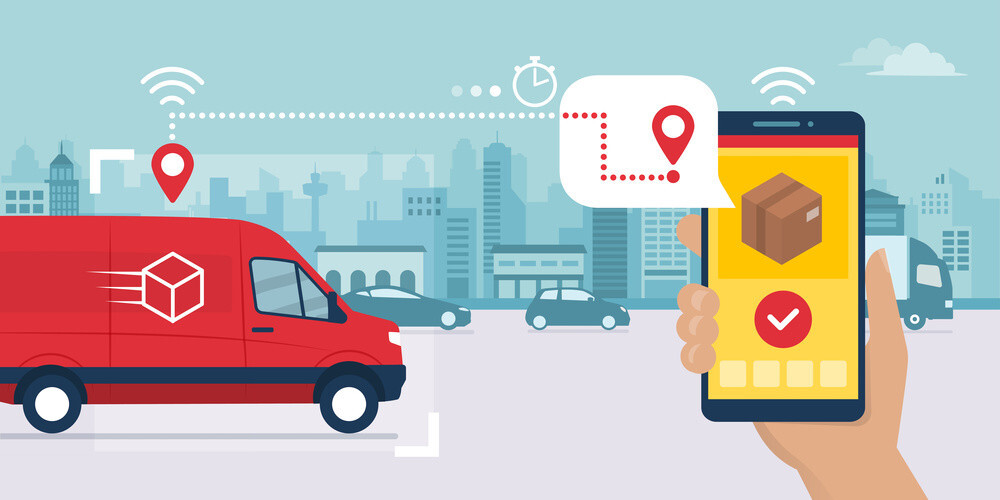The year 2021 is probably a very special year for most of us. It is the year when the world started to get back to normal after a pandemic… This is probably the first we have ever experienced in our lifetime! If we were to be optimistic, we can see the year 2020 as one of the most epoch-making and prolific years for businesses driven by technology.
It might not have been a fruitful year for transportation, tourism, and air travel. However, a lot of business streams saw an unprecedented boom because of the lockdown and the norms imposed on social distancing. If we were to look at one common feature among the most profitable businesses in 2020, it could be encapsulated in two words: “on-demand“.

Introducing the on-demand delivery world
A lot of businesses, ever since ‘business‘ started as a concept, have been struggling to find out who their customers are and where exactly they are and have been struggling even more so to find out when exactly do they need a product or service. This gap has been effectively addressed by the on-demand business model.
Good business transformations are about making luxuries affordable. The on-demand business model did exactly that. It all started with the ride-hailing company from San Francisco called Uber. With a simple mobile app, they made it possible for people who want a cab to connect with people who drive a cab. The GPS made it possible for both parties to meet at a proper location without any confusion or discrepancy.
The Uber model has expanded to almost every service possible that today, whether we want to order pizza or pet walkers or plumbers, we count on on-demand apps. The diversity of revenues makes these on-demand businesses a lucrative target for entrepreneurs.

The different revenue models for on-demand delivery app
There are different modes in which an on-demand app earns its revenue.
The most common avenue for revenue with these on-demand businesses is the commissions that people can earn from merchants and service providers. In essence, these on-demand apps provide merchants with additional customers and they can take a commission set by percentage from the gains of the merchant.
Some on-demand apps top this revenue up with delivery charges wherever applicable. The delivery charges are fees paid for the logistic services. Some of them charge a flat delivery fee and some of them charge their delivery fee by the distance, the weight, and the type of consignment. This revenue model is applicable for food delivery, grocery delivery, and medicine delivery.
Going with the age-old demand and supply equation, some on-demand businesses increase the price of their offerings when the demand is high. This was infamously known as the surge pricing introduced by Uber. The same business model can also be applied for on-demand restaurant food delivery during lunch or dinner time. This puts a block on the side of the customer because they do not have an option to bargain and the “luxury“ becomes a “necessity.“
Most mobile apps have a facility to advertise within their application. The advertising facility is provided by the creators of the operating systems, making them a dependable source of revenue. The app can be paid according to the number of times an ad is being clicked or the number of times an ad is being shown. In addition to the advertising options offered by Google and Apple, apps can also consider tying up with third-party advertisement providers for added revenue. It should be made sure that the advertisement does not interfere or intrude in the core revenue-generating mechanism.
Your app can also incorporate a premium model where some features are available for a paid subscription. These can include free deliveries, combo packs, free pick up and drop for vehicle service, free servicing options, and discounts and offers. The apps can also consider integrating an e-commerce store within the app which comes in handy for industries like beauty and pet grooming.
The on-demand delivery business: which one to go for?
The scope of on-demand businesses is as big as the scope for service businesses. There are a lot of possibilities that have still not been explored. With meticulous research, however, it is possible for you to find out the right business for you. Launching an on-demand delivery app has become the best business opportunity.
On-demand business or any business for that matter is bound to succeed only when it addresses the pain points of a specific segment of the audience. You can study your audience by using online services, social networking focus groups, and even engage in personal surveys. It is these precious pieces of data that would help in building your app idea.
Sometimes, you might have people competing for the same business. If we were to look at the success of Ola and Uber in India, it only proves that competition can coexist peacefully and profitably. However, if you can find out the misgivings of your competitor and act accordingly to include features that address that particular issue, you can carve a niche of your own.
You can consider posting your idea on assessment platforms like Product Hunt where you can measure the popularity of your startup idea. This will also help you craft certain basics of your product like the product description, the visual content, and the desktop icon. The questions asked by the participants will also give you a clear idea of what people actually expect.
Once you have convincing answers to all these questions, you can consider developing your minimum viable product (MVP) and test it across a limited set of users with limited functions. These users can give you the essential feedback it makes to perfect your product.
With these questions and answers, it becomes possible for you to build the perfect product for your users. Some research has already been done and some of these fields have been found to be lucrative.
The delivery businesses in need
Although there are on-demand service providers for these businesses, some businesses can still accommodate new players and we have listed them for you here.
Courier service:
Peer-to-peer courier service is the need of the year. Earlier, couriers were confined to just a few packages and the need to send packages to people at a personal level was quite sparse. In most cases, it used to be intercity parcels for students and workers in the family who do not stay at home. Today, a lot of home businesses have started to thrive and there is a need for those business people to transport their creations from one place to another, mostly within the city. There are some specialized services like dry cleaning that might need transportation/logistics support. Considering all these factors, courier service on demand is surely a lucrative business model to look for.
Packing and moving:
Gone are the days when people used to just stick to one job and live in one city. Today, considering factors like career and livelihood, there’s a constant need for people to move from one city to another. As the homes become bigger, transportation becomes proportionally difficult. By introducing packing and moving services on demand, you can help meet the needs of these customers by using information like the place of origin, the destination, and the approximate size of the consignment.
The technical skeleton
The on-demand app ecosystem is made of three distinct components: the user, the service provider, and the administrator. In some cases, there might also be a delivery executive involved.
The user should be able to sign up for the services provided without much hassle. They should be able to sign up using their phone number or email address or legacy credentials. The sign-up should immediately create a profile for them that contains information on their locations, their default payment instruments, and the list of services they have availed of.
They should also be provided with a payment gateway that can accept multiple payment instruments. They should also be able to submit reviews and ratings for the services that they have available off. Push notifications should be effectively used for the benefit of the customer by providing them with offers and discounts.
The service provider should be provided with an app that lets them easily sign up and also verify their identity by uploading documents. They should have the flexibility to either accept or reject the requests that they get. They should get their payments transferred to their bank accounts as soon as possible.
Some on-demand businesses might have a need for delivery executives. These delivery executives, just like service providers, should be able to easily verify and sign up. Since these delivery providers, in most cases, are gig workers, they should have an option to toggle their availability. They should also have their payments credited to their bank accounts without any hassle. If possible, that should be a referral system where they can refer new delivery executives, so the business can expand its operations. These referrals should be monetarily incentivized.
For all the three entities mentioned above, it would not be an exaggeration to say that the GPS is the epicenter of operations. The GPS on the customer device helps in alerting the service providers and delivery executives in the vicinity. It can also get real-time updates for customers to keep them informed on the moment of the delivery executive/driver. These drivers can use the GPS/mapping/navigation combination to flawlessly navigate and reach The intended destination without any confusion.
An administrator is given the responsibility of maintaining the sanity of the app. They should take care of the content on the app interface, the offers and promotions, and the commercial elements like the existing commission rates. They should also have the power to suspend and disable users, delivery executives, and service providers. Administrators are also responsible for customer support and they can delegate it to a team if needed. They should be provided with an intuitive and comprehensive dashboard that gives the details on the vital stats of the app including but not limited to the number of active orders, the number of active service providers and drivers, and revenue and at any given time.
Conclusion
It cannot be denied that on-demand is the way forward. There are some abs that have redefined the game by providing multiple services within a single app. The possibilities are practically unlimited! If you would like to launch your own delivery app, you will need to invest in the technology it requires to create a delivery app.
Thankfully, it is not that cumbersome anymore… thanks to the availability of white label solutions like the Gojek clone app. You can now get in touch with the company that specializes in this white label solution. The degree of customizability offered by these white label clone apps ensures that your app has all the branding elements that you require, so you can launch your own on-demand app in the shortest possible time!
Read Related Article : OnQall Clone App Lets Your User Hire Range of Needs at Economical Price
Author Bio
Jennifer Atkinson is a business advisor and growth hacker at Appdupe. She helps the new-age entrepreneurs in launching their online business and market it to reach the end-users. In the weekends, you can find her reading Stephen king’s books and other horror books.








